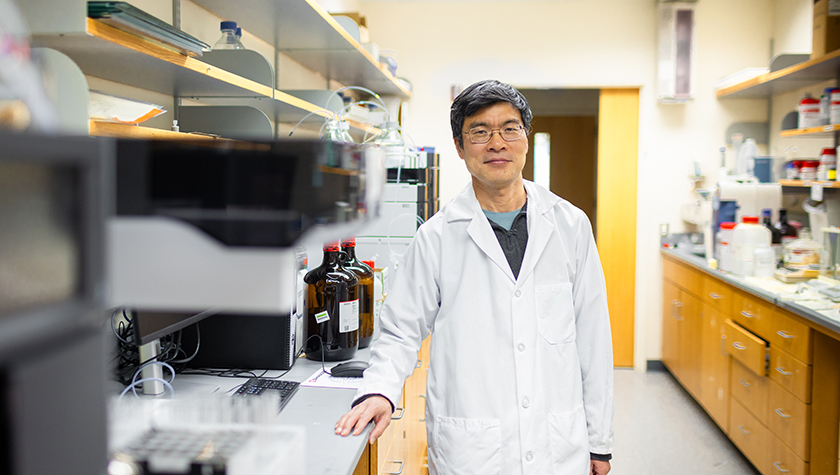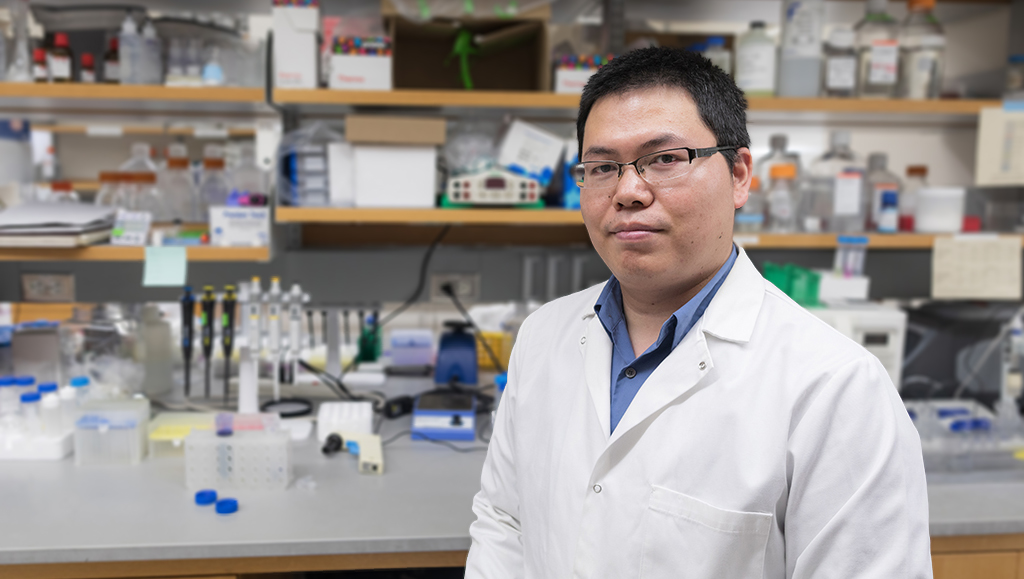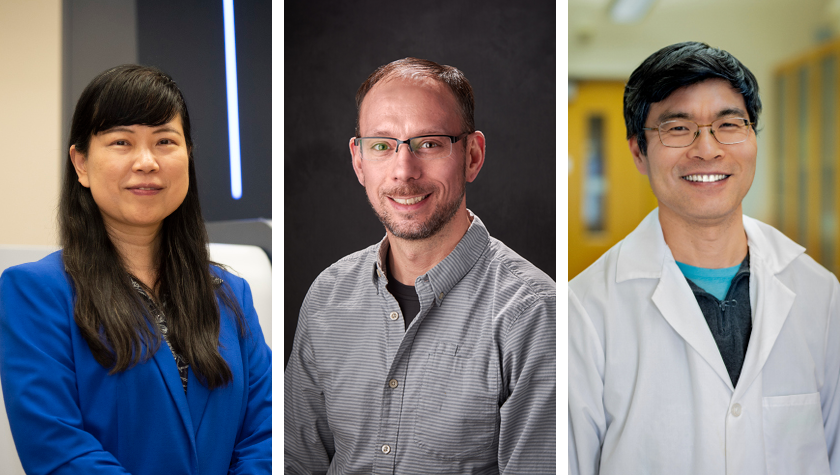
Professor Weiping Tang creates a new type of molecule to tag proteins on the surface of cancer cells for degradation
By Nicole Sweeney Etter
Despite decades of research-bolstered progress, cancer remains an insidious foe. Now Weiping Tang, the Janis Apinis Professor of Pharmaceutical Sciences and director of the Medicinal Chemistry Center at the University of Wisconsin–Madison School of Pharmacy, is focused on a promising new approach that could lead to more targeted and effective treatments: leveraging the body’s own protein disposal system to selectively destroy proteins that cancer cells rely on to grow and thrive.
Tang developed a new type of molecule called folate receptor targeting chimeras (FRTAC), which binds simultaneously to the folate receptor and a target protein on the surface of cancer cells. Acting as a connector, the FRTAC initiates the endocytosis process to direct the target protein to the lysosome, the body’s normal machinery for degrading and recycling extracellular proteins.
Folate receptors play a key role in cellular functions and are overexpressed in many types of tumors, including ovarian, breast, lung, kidney, and head and neck cancers — making them a promising target for cancer drug delivery.
“Building on the extensive body of knowledge in the drug delivery literature, we investigated the potential of folate receptors beyond traditional drug delivery applications. Specifically, we explored their utility in the emerging field of targeted protein degradation (TPD), leveraging their ability to mediate selective uptake and degradation of disease-associated proteins,” Tang explained.
The FRTAC approach successfully reduced tumor growth in an animal model, and Tang and his collaborators recently published their findings in Nature Communications.
“Our goal here in the School of Pharmacy is really pushing the frontier of drug discovery development and new modalities, and that is what we’re doing.”
—Weiping Tang
“Our group is the first to demonstrate the degradation of the extracellular target protein in the disease-relevant tissue — in our case, cancer — in the TPD field,” Tang said. “We also showed we could use this modality to degrade a couple of other target extracellular proteins, so this is a new platform.”
With support from a new, five-year RO1 grant from the National Institutes of Health, the Tang Research Group will continue to develop novel antibody conjugates to degrade harmful extracellular proteins and improve cancer immunotherapy treatments.
“In general, we’re trying to develop this new modality to eliminate the disease-associated protein, which is different from the traditional way of inhibiting the function of the protein,” Tang explained. “This is important because many disease-associated proteins have multiple functions. A degrader can completely eliminate these proteins, whereas traditional inhibitors are limited to blocking just one specific function.”
Tang has been studying protein degradation using proteolysis targeting chimeras, or PROTACs, for about a decade. His earlier research has shown that PROTAC degraders are effective in targeting myeloma, breast cancer, and leukemia.

However, PROTAC degraders are limited to intracellular proteins because they rely on the proteasome to destroy the unwanted proteins. Then a few years ago, Tang became interested in targeting extracellular proteins, which make up 40% of proteins expressed and require a different mechanism for destruction: the lysosome.
“It’s great to have a complementary tool to cover the proteins outside the cell,” he said. “So right now we are dividing our effort, and we’re working on both the degradation of intracellular proteins with PROTACs and also extracellular proteins with the new FRTACs.”
Pharmaceutical companies, biotechnology startups, and other labs are also racing to harness the power of TPD. To support other researchers working in this area, Tang’s team has created a protein degradation platform with pre-built partial PROTAC libraries that could then be customized by researchers to target specific intracellular proteins — speeding up what had been a labor-intensive process of creating each PROTAC molecule from scratch.“We continue working in that space, and that platform has attracted many collaborators from UW and other institutes,” Tang said. “We’ve started collaborating with more and more researchers to degrade their favorite target protein using the platform.”
However, extracellular protein degradation has received less attention — until recently. One of the biggest challenges of the FRTAC work has been collecting data on in vivo efficacy.
“Seeing the activity in the cell is one thing,” he said. “Seeing the activity in an animal is almost a completely different story. We tried a number of different runs to adjust different parameters and dosing.”
And there’s still more work to be done. His team will continue to optimize the activity of FRTAC and study the mechanism of action, and it could be another decade or two before this research is ready for the patient’s bedside, he said.
“With hundreds of different post-translational modifications to potentially target, I’m excited to explore and expand these possibilities in the near future.”
—Weiping Tang
But industry partners can help speed up the process. In 2022, Tang co-founded a business called Chimergen Therapeutics, which is working to develop novel treatments for cancer and autoimmune diseases.
“It’s not possible to develop a drug within the academic lab from the beginning to the end. At some point, you need to get the industry buy-in and then move it further, and that’s one reason why we actually started the company,” he said. “But our goal here in the School of Pharmacy is really pushing the frontier of drug discovery development and new modalities, and that is what we’re doing.”
The Tang Research Group’s recent work also paves the way for other drug development possibilities.
“The key lies in designing molecules to bring together two entities that don’t naturally interact,” he said. “We have focused on bringing the target protein into close proximity with an effector capable of destroying it. But there are many other potential applications of this approach by facilitating interactions between two proteins or two other molecular components. With hundreds of different post-translational modifications to potentially target, I’m excited to explore and expand these possibilities in the near future.”

